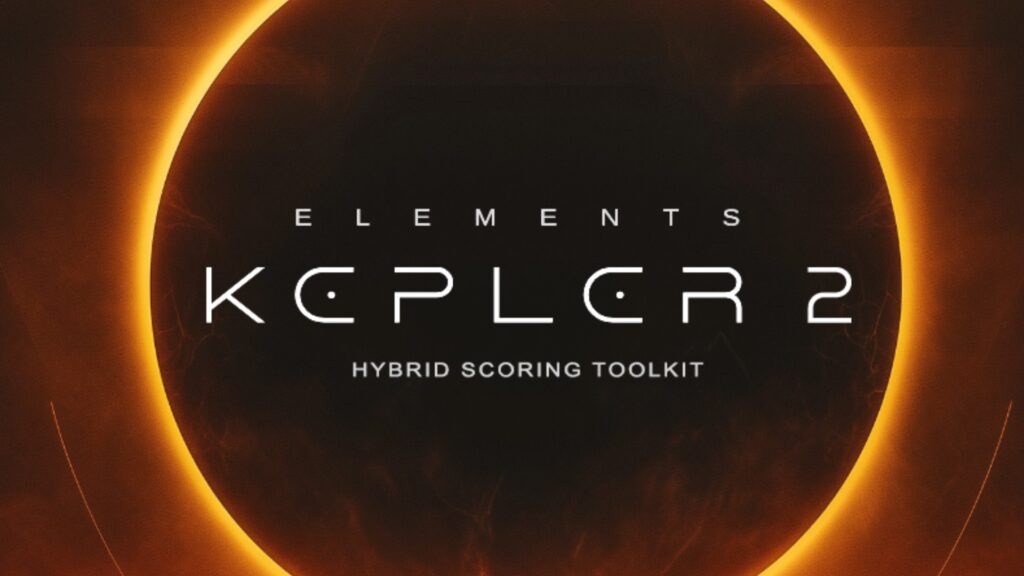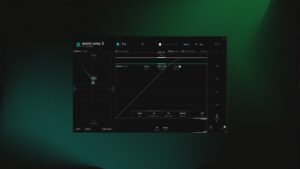There are some libraries that immediately pull you in — not just with sound, but with atmosphere. Zero-G’s Kepler 2 is one of those. The first Kepler was already one of the most inspiring hybrid scoring instruments I’d ever used. It felt cinematic, expressive, and to my surprise it was more versatile than expected, with a wide range of instruments at your disposal. But this new chapter… this one goes further. Kepler 2 doesn’t just continue the series — it expands it into a darker, deeper, more gravitational world of sound design and scoring power.
When Zero-G teased the follow-up, I knew expectations would be high. The first Kepler had already become a bit of a secret weapon for many composers. And now, with Kepler 2, they’re not playing it safe — they’re rebuilding the entire system. This is a full re-imagining, not just an update. From its new engine to its redesigned interface and a mountain of fresh content, it’s the kind of release that feels less like an update and more like a rebirth.
The Basics
Let’s get the technical stuff out of the way first. Kepler 2 runs in the full version of Kontakt 8.6 or higher — it will not work in the free Kontakt Player. You’re looking at 47 GB of content, over 1,300 presets, and a price of $149.95, with a three-week intro price of $126.95. If you’re upgrading from Kepler 1, it’s just $50, which, let’s be honest, is a no-brainer. There’s also a loyalty discount for Ethera and Elements users.
That upgrade pricing alone sets the tone for what Zero-G is doing here: delivering something massive without overcharging. They could have easily treated this as a brand-new product. Instead, they’ve given existing users an extremely generous path forward — and that generosity extends to the library itself.
The Concept: A Toolkit, Not a Toy
Zero-G has a certain approach to design that I really appreciate. Their instruments rarely feel like one-trick ponies — they’re more like cinematic toolkits, packed with different components that you can pull apart and build your own thing from. Kepler 2 continues that tradition. It’s not just a pad generator or a pulse engine. It’s a hybrid scoring ecosystem.
Inside, you’ll find everything from motion strings and hybrid percussion to distant choirs, rhythmic synths, and organic sequences. It’s clearly inspired by the sound world of modern sci-fi and epic scoring — somewhere between Dune, Tenet, and Blade Runner 2049 — but there’s plenty of room to make it your own.
“It’s so full. It’s so punchy. It’s so mature. This is made by someone who understands cinematic mixing.”
The sound design comes from Stefano Maccarelli, whose name you might recognize from the Ethera series. His fingerprints are all over this — the balance between musicality and texture, the polish of the mixes, and the attention to detail in how each sound sits in a score. You can tell it was made by someone who doesn’t just build instruments, but scores with them.
The Sound: Bigger, Darker, and More Polished
The first Kepler was already impressive in its range. Kepler 2 expands that in almost every direction. The Instant Cue presets are the perfect starting point — they’re cinematic cues in a box, often combining rhythmic low-end pulses with shimmering highs and evolving motion. Some sound ready to drop straight into a trailer. Others feel like full cues waiting for a melody.
“There’s a nice sense of visceralness — like a thump hitting you — but it’s all very polished.”
That’s the thing about this library: it feels alive. It breathes, it moves, it reacts. There’s weight and texture, but also space. The percussion slams, the strings shimmer, the synths roar — but nothing is harsh or muddy. Everything sounds as if it’s been carefully pre-mixed by a film-score engineer. These are sounds that already sit in the pocket, ready to drop into a session.
The Interface: Kontakt 8 Meets a Black Hole
When you open Kepler 2, you’re greeted by a pulsing, cosmic black hole animation — a fitting visual metaphor. The whole GUI has been rebuilt for Kontakt 8, and it shows. The interface feels more modern, smoother, and more intuitive.
The top navigation bar includes tabs for Space, EQ, Dynamics, Shape, XY Control, Macros, Slice, Arp, and Input Quantize. It’s logical and easy to navigate, and each tab opens within the same window, so you never lose sight of the main controls.
There are still a few quirks. The Learn Range button, for instance, could use a more obvious visual cue, and the Input Quantize slider animation is a bit jumpy. The interface elements such as the selector squares used for the layers are quite basic-looking. But once you get used to it and know where things are, it’s fast and fluid.
Layers, Engines, and Endless Presets
At its core, Kepler 2 runs on three main engines: the Core Designer, Texture Designer, and Synth Designer. Each serves a slightly different role in hybrid scoring — from deep textural design to more rhythmic or melodic duties. The layering system lets you combine up to three sources at once, and this is where things get powerful.
“Kepler 2 feels like a toolkit, not just a library. You can mix, layer, and design your own hybrid sound in minutes.”
There’s an enormous amount of source material here — 47 GB’s worth — and the categorization helps a lot. Sounds are grouped by function and color: low, high, metal, organic, distorted, hybrid, guitar, clock, vocal, and so on. You can find the usual controls of ADSR, filter, offset, and shape controls, so sculpting something personal is quick and rewarding.
While Kepler 2 has some absolutely jaw-dropping sequences and melodic patterns, many of them are baked into the source samples themselves, meaning that you cannot jump in there and change the melody or harmonisation. Clever sample use and tweaking can in many cases give you some adjustment leeway, but just know that sometimes you can’t chop things up to be exactly what you want, if the source sample pattern is not to your liking.
And yes, it’s easy to get lost in the presets. But it’s the good kind of lost — the creative kind. Each patch feels like an invitation to write something.
The Strings, The Guitars, The Grit
A big highlight of Kepler 2 is the inclusion of the Bow in Motion string instruments — and I don’t say this lightly: this section alone could have been released as its own library.
These are not your usual polished pad-like string textures. They feel alive, organic, and breathing — every bow stroke and scrape carries an emotional weight that’s hard to fake. When you play them, there’s a subtle resistance under your fingers, like you’re physically pulling sound out of the instrument rather than just triggering it. It’s that tactile sensation that makes Kepler 2’s strings so addictive to play.
What struck me most was how they manage to sit right at the intersection between cinematic power and human imperfection. You can hear the rosin, the microdetuning, the tiny mechanical noises that give the samples their soul. There’s movement in every note — a shimmer that feels both acoustic and otherworldly, especially when layered under the synth textures.
These strings have a musical intelligence to them — they know when to support and when to lead. There are emotional high textures that sound like they’ve been pulled straight from a film score.
“The strings are very powerful — they sound like they’ve been played, not programmed. The attention to detail both texturally as well as emotionally is superb.”
And then there are the guitars. The processed ones in particular have that chewy, satisfying texture you only get when the source is beautifully recorded and creatively mangled. They bite, but they never feel harsh. They sound designed — as if they were sculpted for modern hybrid scores, ready to sit under drums and synths without ever fighting for space.
“These guitars go hard. Beautifully played, captured, sampled — really full and satisfying.”
The combination of these tactile strings, gritty guitars, and textural hybrids gives Kepler 2 its unexpected but extremely welcome new heart. It’s where the organic meets the synthetic — that sweet spot where the human and machine blur together into something bigger, something cinematic.
Value and Verdict
There’s no question that Kepler 2 delivers exceptional value. Even at full price, one could argue it is underpriced for what it offers. The upgrade price of $50 is absurdly good. You could easily justify that cost for the Instant Cue folder alone.
“This is a tremendous toolkit. You can make serious music with this — it should pay itself back easily.”
At this point, Kepler 2 feels like more than just a sample library. It’s a full environment for cinematic writing. You can sketch ideas, produce finished cues, or layer it into your existing orchestral or electronic palette. It’s a dark cinematic playground that makes you want to write.
If Kepler 1 was the prototype, Kepler 2 is the vessel reaching escape velocity.
Final Thoughts
Zero-G’s Kepler 2 stands as a statement piece for modern dark and cinematic hybrid scoring. It’s ambitious, versatile, and deeply musical. It takes everything the first Kepler did well and pushes it into uncharted territory. The new engine, the upgraded look design, the quality of the sounds — it all feels like a confident step into the future. If you write dark cinematic music of any kind — from sci-fi to emotional drama — this belongs in your arsenal.
And if you already own Kepler 1? That $50 upgrade is a gravitational pull you probably shouldn’t resist.
Get it here: https://zero-g.co.uk/products/elements-kepler-2
Prefer video?
Full review: https://youtu.be/6urjp-tVTGg
No talking edit: https://youtu.be/wkqGF-Xarjw





